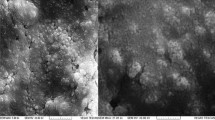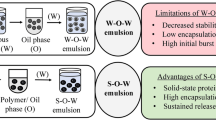Abstract
Pediocin is small antilisterial polypeptide bacteriocin. Direct addition of pediocin has been studied so far and is found to be effective only for a limited duration of time. The controlled release or slow release is an efficient method to prolong the effectiveness of pediocin and other such antimicrobials. Encapsulation is one of the numerous strategies that can be employed for achieving controlled release. Diverse wall materials such as phospholipids, proteins and carbohydrate polymers and combinations of these are used to encapsulate active ingredients. One of the aims of this study was to evaluate the effect of process parameters, viz. concentration of phospholipid (lecithin, phophatidylcholine) at the rate of 0.1, 0.2 and 0.3 % (w/v), amplitude for sonication (40, 50 and 60 %) and sonication time (3, 5 and 7 min), on size of nanoliposomes. There was an increase in liposome size with increase in concentration of phospholipids; however, there was decrease in size with increase in amplitude and duration of sonication. The main aim of the study was to compare the controlled release behaviour of pediocin loaded in delivery systems of different wall materials, viz. nanoliposomes (lecithin, phophatidylcholine), capsules of alginate plus guar gum and hybrid capsules of alginate plus guar gum incorporated with nanoliposomes. Encapsulated pediocin was found to be more effective in inhibiting bacterial growth than directly added pediocin. Hybrid capsules of alginate plus guar gum incorporated with pediocin-loaded nanoliposomes of phosphatidylcholine were found to be the best delivery system for controlled release of pediocin.



Similar content being viewed by others
References
Turcotte, C., Lacroix, C., Kheadr, E., Grignon, L., Fliss, I. (2004). A rapid turbidometric microplate bioassay for accurate quantification of lactic acid bacteria bacteriocins. International Journal of Food Microbiology, 90, 283–293.
Papagianni, M., & Anastasiadou, S. (2009). Pediocins: the bacteriocins of pediococci. Sources, production, properties and applications. Microbial Cell Factories, 8(3), 1–16.
Rodríguez, J. M., Martínez, M. I., Kok, J. (2002). Pediocin PA-1, a wide-spectrum bacteriocin from lactic acid bacteria. Critical Reviews in Food Science and Nutrition, 42, 91–121.
Drider, D., Fimland, G., Hechard, Y., McMullen, L. M., Prévost, H. (2006). The continuing story of class IIa bacteriocins. Microbiology and Molecular Biology Reviews, 70, 564–582.
Grande, M. J., Lucas, R., Valdivia, E., Abriouel, H., Maqueda, M., Omar, N. B., Amero, M. M., Gaolvezl, A. (2005). Stability of enterocin AS-48 in fruit and vegetable juices. Journal of Food Protection, 68(10), 2085–2094.
Ouattara, B., Simard, R. E., Piette, G., Bin, A., Holley, R. A. (2000). Diffusion of acetic and propionic acids from chitosan-based antimicrobial packaging films. Journal of Food Science, 65, 768–773.
Thomas, L. V., & Delves-Broughton, J. (2005). Nisin. In P. M. Davidson, J. N. Sofos, & A. L. Branen (Eds.), Antimicrobials in food (3rd ed., pp. 237–274). Boca Raton: CRC.
Balasubramanian, A., Lee, D. S., Chikindas, M. L., Yam, K. L. (2011). Effect of nisin’s controlled release on microbial growth as modelled for Micrococcus luteus. Probiotics and Antimicrobial Proteins, 3, 113–118.
Were, L. M., Bruce, B., Davidson, P. M., Weiss, J. (2004). Encapsulation of nisin and lysozyme in liposomes enhances efficacy against Listeria monocytogenes. Journal of Food Protection, 67, 922–927.
Prombutara, P., Kulwatthanasal, Y., Supaka, N., Sramala, I., Chareonpornwattana, S. (2012). Production of nisin-loaded solid lipid nanoparticles for sustained antimicrobial activity. Food Control, 24, 184–190.
Millette, M., Tien, C. L., Smoragiewicz, W., Lacroix, M. (2007). Inhibition of Staphylococcus aureus on beef by nisin-containing modified alginate films and beads. Food Control, 18, 878–884.
Were, L. M., Bruce, B. D., Davidson, P. M., Weiss, J. (2003). Size, stability, and entrapment efficiency of phospholipid nanocapsules containing polypeptide antimicrobials. Journal of Agricultural and Food Chemistry, 51, 8073–8079.
Malheiros, P. S., Daroit, D. J., Brandelli, A. (2010). Food applications of liposome-encapsulated antimicrobial peptides. Trends in Food Science and Technology, 21, 284–292.
Malheiros, P. S., Daroit, D. J., Silveira, N. P., Brandelli, A. (2010). Effect of nanovesicle-encapsulated nisin on growth of Listeria monocytogenes in milk. Food Microbiology, 27, 175–178.
Taylor, T. M., Bruce, B. D., Weiss, J., Davidson, P. M. (2008). Listeria monocytogenes and Escherichia coli O157:H7 inhibition in vitro by liposome-encapsulated nisin and ethylene diaminetetraacetic acid. Journal of Food Safety, 28, 183–197.
Taylor, T. M., Davidson, P. M., Bruce, B. D., Weiss, J. (2005). Ultrasonic spectroscopy and differential scanning calorimetry of liposomal-encapsulated nisin. Journal of Agricultural and Food Chemistry, 53, 8722–8728.
Chonn, A., & Cullis, P. R. (1998). Recent advances in liposome technologies and their applications for systemic gene delivery. Advanced Drug Delivery Reviews, 30, 73–83.
Schroeder, A., Kost, J., Barenholz, Y. (2009). Ultrasound, liposomes, and drug delivery: principles for using ultrasound to control the release of drugs from liposomes. Chemistry and Physics of Lipids, 162, 1–16.
Watwe, R. M., & Bellare, J. R. (1995). Manufacture of liposomes: a review. Current Science, 68, 715–724.
Maulucci, G., De Spirito, M., Arcovito, G., Boffi, F., Castellano, A. C., Briganti, G. (2005). Particle size distribution in DMPC vesicle solutions undergoing different sonication times. Biophysical Journal, 88, 3545–3550.
Moran, C., Ross, J., Cunningham, C., Butler, M., Anderson, T., Newby, D. (2006). Manufacture and acoustical characterisation of a high frequency contrast agent for targeting applications. Ultrasound in Medicine and Biology, 32, 421–428.
Pereira-Lachataignerais, J., Pons, R., Panizza, P., Courbin, L., Rouch, J., Lopez, O. (2006). Study and formation of vesicle systems with low polydispersity index by ultrasound method. Chemistry and Physics of Lipids, 140, 88–97.
Chan, E. S., Wong, S. L., Lee, P. P., Lee, J. S., Ti, T. B., Zhang, Z., et al. (2011). Effects of starch filler on the physical properties of lyophilized calcium–alginate beads and the viability of encapsulated cells. Carbohydrate Polymers, 83(1), 225–232.
Fu, S., Thacker, A., Sperger, D., Boni, R., Buckner, I., Velankar, S. (2011). Relevance of rheological properties of sodium alginate in solution to calcium alginate gel properties. AAPS PharmSciTech, 12(2), 1–8.
Hay, I. D., Rehman, Z. U., Ghafoor, A., Rehm, B. H. A. (2010). Bacterial biosynthesis of alginates. Journal of Chemical Technology and Biotechnology, 85(6), 752–759.
Hian, G. C., Sia, H. P. W., Wah, C. L. (2012). Alginates as a useful natural polymer for microencapsulation and therapeutic applications. Carbohydrate Polymers, 88(1), 1–12.
Narsaiah, K., Jha, S. N., Bhardwaj, R., Sharma, R., Kumar, R. (2011). Optical biosensors for food quality and safety assurance—a review. Journal of Food Science and Technology, 49(4), 383–406.
Wang, Q., Ellis, P. R., Ross-Murphy, S. B. (2002). Dissolution kinetics of guar gum powders. I. Methods for commercial polydisperse samples. Carbohydrate Polymers, 49(1), 131–137.
Dai, C., Wang, B., Zhao, H., Li, B. (2005). Factors affecting protein release from microcapsule prepared by liposome in alginate. Colloids and Surfaces. B, Biointerfaces, 42, 253–258.
Das, S., Kiong, W., Kanauji, P., Kim, S., Reginald, B. H. T. (2011). Formulation design, preparation and physicochemical characterizations of solid lipid nanoparticles containing a hydrophobic drug: effects of process variables. Colloids and Surfaces. B, Biointerfaces, 88, 483–489.
Jafari, S. M., He, Y., Bhandari, B. (2007). Production of sub-micron emulsions by ultrasound and microfluidization techniques. Journal of Food Engineering, 82, 478–488.
Chi-Zhang, Y., Yam, K. L., Chikindas, M. L. (2004). Effective control of Listeria monocytogenes by combination of nisin formulated and slowly released into a broth system. International Journal of Food Microbiology, 90, 15–22.
Chung, D., Chikindas, M. L., Yam, K. L. (2001). Inhibition of Saccharomyces cerevisiae by slow release of propyl paraben from polymer coating. Journal of Food Protection, 64, 1420–1424.
Mazumdar, N., Chikindas, M. L., Uhrich, K. (2010). Slow release polymer–iodine tablets for disinfection of untreated surface water. Journal of Applied Polymer Science, 117, 329–334.
Bierhalz, A. C. K., Silva, M. A. D., Kieckbusch, T. G. (2012). Natamycin release from alginate/pectin films for food packaging applications. Journal of Food Engineering, 110, 18–25.
Acknowledgments
This work was supported by National Fund for Basis, Strategic and Frontier Application Research in Agriculture, Indian Council of Agricultural Research, New Delhi, through project entitled “Microencapsulation methods for bacteriocins for their controlled release” (Project code no. PHT-2003).
Author information
Authors and Affiliations
Corresponding author
Rights and permissions
About this article
Cite this article
Narsaiah, K., Jha, S.N., Wilson, R.A. et al. Pediocin-Loaded Nanoliposomes and Hybrid Alginate–Nanoliposome Delivery Systems for Slow Release of Pediocin. BioNanoSci. 3, 37–42 (2013). https://doi.org/10.1007/s12668-012-0069-y
Published:
Issue Date:
DOI: https://doi.org/10.1007/s12668-012-0069-y




